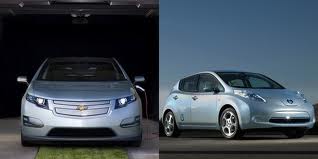The electric cars launched with serious action in the United States includes the Nissan Leaf and the Chevrolet Volt Leaf. The Chevrolet Volt is the only brand of the mass-produced electric cars in the United States.

Nissan Leaf and Chevrolet Volt Leaf
The Chevrolet Volt is a new plug-in hybrid extended range electric car. It is considered as to be at 99 percent level of engineering calibration according to the General Motors. The power for the vehicle is drawn from lithium-ion batteries and a 1.4-liter engine. The vehicle has a sport mode and provides adjustment for pedal mapping. It is delicate and the vehicle’s default mode is normal. By selecting eco settings climate control can be done. This is one of the most interesting feature of the vehicle.
The vehicle can be able to drive for about 40 miles using the battery alone and without gasoline. The base price of the vehicle revealed by the General Motors is $41,000 before a $7,500 federal tax credit. The Chevrolet Volt has a back up power source and provides premium fuel. This gives the vehicle a range of more than 100 miles. The reputation of the General Motors is expected to be given by the Volt among environmentally conscious consumers. This is involved in demonstrating the capabilities of battery-powered vehicles.
The Chevrolet Volt could be connected to a standard 120-volt outlet for charging the 400-pound battery. The company has been offering eight years of warranty. Otherwise it may provide warranty for 100,000 miles three years longer than what is been offered for the gasoline engines. Certain other features of the Volt include a built-in navigation system and hands-free telephone capabilities.
 The vehicle was displayed at the China International Automobile Exhibition at Guangzhou. After starting the sale of the vehicle in the China, it is estimated that the vehicle is to be on sale in more than 170 countries worldwide including the U.S. with different brand names.
The vehicle was displayed at the China International Automobile Exhibition at Guangzhou. After starting the sale of the vehicle in the China, it is estimated that the vehicle is to be on sale in more than 170 countries worldwide including the U.S. with different brand names.